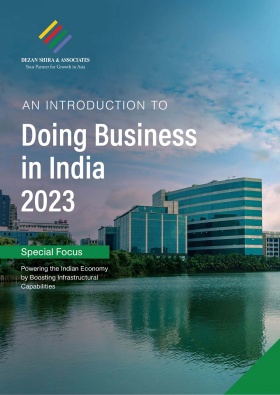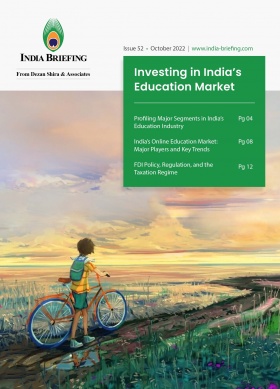India and Australia to Mutually Recognize Education Degrees, Opening Up Commercial Prospects
India and Australia will now recognize each other’s education degrees, in a landmark development that opens wide commercial opportunities for education service providers. As New Delhi continues to prioritize education reforms, Australian entities will gain from exploring opportunities in the vast Indian education market. High growth segments in India’s education sector include K-12 school education and professional upskilling. We discuss the prospects for Australian entities in this brief.
During his maiden four-day India visit, Australia’s Prime Minister Anthony Albanese announced the Mutual Recognition of Educational Qualifications (MREQ) and said that Deakin University will be the first foreign university to gain approval to establish an overseas branch campus in India.
The offshore campus of Deakin University will be established at GIFT City, Gujarat, and will offer courses on cyber security and business analytics, among others. Following this, the University of Wollongong has expressed its interest in setting up an offshore campus at GIFT City.
A new ‘Maitri’ scholarship has also been launched for Indian students studying in Australia for up to four years.
In other related developments, the Australian government has committed to contributing $1.89 million for supporting Indian skill programs in the area of agriculture, a critical sector for the country. Consequently, the Australia-India Education Council (AIEC) has widened its scope to include cooperation in the area of skill development.
Education is Australia’s largest service export to India and was valued at $4.2 billion in 2021. India is the second largest source of international students besides accounting for the largest pool of skilled migrants to Australia. The Australian 2021 Census recorded 976,000 people with Indian heritage, of which 673,000 were Indian-born Australians – 2.6 percent of the total population. As of October 2022, almost 57,000 Indian visa holders were studying in Australia.
Overall, the number of Indian students going overseas has steadily increased – growing from 454,009 in 2017 to 517,998 in 2018, and 586,337 in 2019. While the pandemic saw the number drop to 444,553 in 2021, a six-year peak was recorded in 2022 at 750,365 (Education Ministry data).
Nevertheless, even as India is seen to be a top sourcing country for international students, not every Indian student has the means or capacity to pursue education in a foreign destination. The country’s large and young population is thus a key target market for foreign education sectors, including that of Australia.
The Indian government, in turn, is ambitious about homegrown talent development and upskilling, to be able to successfully tap into what is called the demographic dividend. India’s population will overtake that of China this year, according to a UN estimate. A report from The Economist Intelligence EIU further notes that the median age of Indians is 28.4 years against a China average of 38.4 years.
Moreover, as the working age (ages 15 to 64) will be the majority population cohort till 2100 (Pew Research estimate), India will face significant challenges for job creation. Linked to this will be developing a competitive talent base – if India wants to attract more international investment and foreign capital to create more jobs, it will need higher quality human resources.
The EIU notes that the average duration of schooling in India is only 6.5 years, compared to 8.5 years in Vietnam and 8.9 years in Thailand.
Of course, India’s population totals must be considered for context.
After all, India has the world’s second largest schooling system with over 1.5 million schools and nearly 250 million enrolments. The K-12 schooling sub-segment constitutes more than 50 percent of the overall size of the growing education industry in India.
Further, India’s higher education system has the third largest enrolment after China and the United States. This while there is only a gross enrolment ratio (GER) of 27.1 percent (FY 2019-20). There were 38.5 million students enrolled in 2019-20 – 19.6 million male and 18.9 million female students.
To address these gaps in education access and training, the new National Education Policy 2020 (NEP) has set a target of providing 50 percent of its youth with either higher education or skill education by 2035.
Australian education service providers may want to explore opportunities in this area, investing in or collaborating with Indian institutions, edtech (education technology) startups, online service providers, universities, and research organizations.
Categories of the Digital Learning Market in India and Key Players
The digital learning market in India is categorized into following segments: K-12, test preparation, online certification, skill development, and enterprise solution. The major growth drivers of these segments include a large addressable market, convenience, price advantage, as well as pandemic-led disruptions, aided with ever evolving technology capabilities.
K-12: With the current enrolment of more than 250 million, the K-12 segment is the largest and most attractive segment for digital learning providers in India. In this segment of e-learning, further sub-segments include smart class solutions, online tutoring, online preparation for exams, simulation and virtual reality, STEM learning, AR and robotics, and assessment. Prominent Indian players in this segment are Cuemath, STEPapp, Whitehat Jr, and CampK12.
Test preparation: It is another emerging Edtech segment that has continued to evolve in the past few years, with a larger number of users relying on these platforms to prepare for competitive exams like JEE, NEET, CAT, IAS, GRE, and GMAT. This is mainly due to the convenience and cost effectiveness of these platforms. Training institutions, such as Career Launcher and T.I.M.E, and top B-schools like IIM-Ahmedabad and IIM-Kozhikode have started offering hybrid courses (combination of online as well as offline) in the test preparation segment. The key players in this segment are Byju’s, Unacademy, Vedantu, Toppr, Embibe, and Gradeup.
Online certification: Employability is the key factor driving the popularity of online professional education. Big data, project management, mobile app development, cloud computing, and digital marketing are some courses that are undertaken by professionals for upskilling. The prominent Indian players in this segment are Coursera, upGrad, Eruditus, Simplilearn, Jigsaw Academy, etc.
Skill development: Edtech startups are enabling faster skill development, further upskilling, and reskilling of gig economy workers and those in entry-level technology roles. Additionally, they are bringing engineers and software developers up to speed with the latest and most adopted technologies. Key players in this segment include Disprz, InterviewBit, Quizizz, Edureka, and Crio.Do.
Enterprise solution: This segment has witnessed maximum growth as companies are integrating such solutions to stay sustainable in a pandemic world. The major market players in this segment are Liqvid, Classplus, Foradian, Schoolguru, Byndr, etc.
|
Education as Percentage of Consumption Expenditure in India, Key Markets: World Bank |
|
|
India |
4.6% |
|
China |
5.6% |
|
US |
2.2% |
|
Brazil |
4.1% |
|
UK |
2.3% |
|
Indonesia |
3.7% |
|
Japan |
2% |
About Us
India Briefing is produced by Dezan Shira & Associates. The firm assists foreign investors throughout Asia from offices across the world, including in Delhi and Mumbai. Readers may write to india@dezshira.com for more support on doing business in in India.
We also maintain offices or have alliance partners assisting foreign investors in Indonesia, Singapore, Vietnam, Philippines, Malaysia, Thailand, Italy, Germany, and the United States, in addition to practices in Bangladesh and Russia.
- Previous Article Strengthening India-Australia Ties After ECTA, PM Anthony Albanese Visit
- Next Article PAN Application Procedure in India: A Step-by-Step Guide









